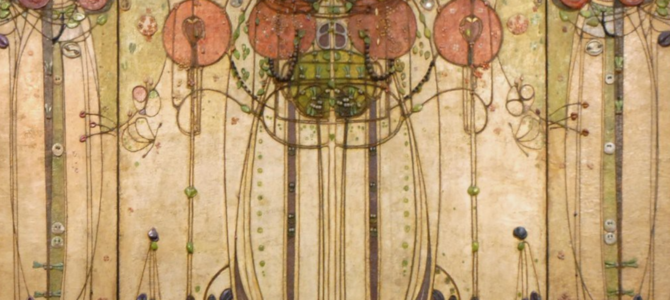
The new Walters Art Museum exhibition, “Designing the New: Charles Rennie Mackintosh and the Glasgow Style,” explores the life and career of one of Scotland’s most singular architects and designers, in the wider context of the avant-garde art environment that existed in late-19th and early-20th century Glasgow.
The show tracks not only the life and career of Charles Rennie Mackintosh (1868-1928) but also the development of the Glasgow School of Art to which he belonged, and whose premises he famously designed. The well-publicized destruction of that building in two massive, devastating fires that took place in 2014 and 2018 were a major loss to art history, making the Walters show a highly timely exhibition that’s absolutely worth seeing.
Yet even this retrospective helped me to understand a great deal more about Mackintosh than I had previously, particularly in gaining a greater appreciation for the role collaboration played in his work, especially with women artists and patrons. To my mind, he and his set still remain rather ambiguous figures in the history of art.
First off, kudos to the Walters for putting on a splendidly comprehensive show about an architect and his contemporaries, without being able to take us inside one of any of their buildings. Short of actually heading over to Scotland, this exhibition is probably the closest you’ll ever be able to get to fully immersing yourself in the eclectic social and cultural atmosphere of Glasgow, circa 1900.
The museum does an excellent job in showing the work of Mackintosh side by side with the work of other members of his circle, as well as bringing in works that exemplify what was influencing the Glasgow style, what they were reacting against, and thereby giving a great deal of depth and texture to the show. Visitors to the Walters, particularly those who have never heard of either Mackintosh or the Glasgow style before, would otherwise probably have felt a bit lost.
Mackintosh Appearances on the Silver Screen
Yet even if the name Charles Rennie Mackintosh is unfamiliar, chances are some of his most famous designs are recognizable. His “Argyle Chair” (c. 1897-1899), for example, has appeared on the large and small screen many times. Sean Young preens on one in Harrison Ford’s apartment in the sci-fi classic “Blade Runner,” while Raúl Juliá, Anjelica Huston, and their brood sit down to dinner on Argyle Chairs in “The Addams Family.” The chair can be seen in episodes of “Star Trek: The Next Generation,” “Babylon 5,” and “Dr. Who,” while in her “Express Yourself” video, Madonna crawled catlike through a suite of them to reach a bowl of milk.
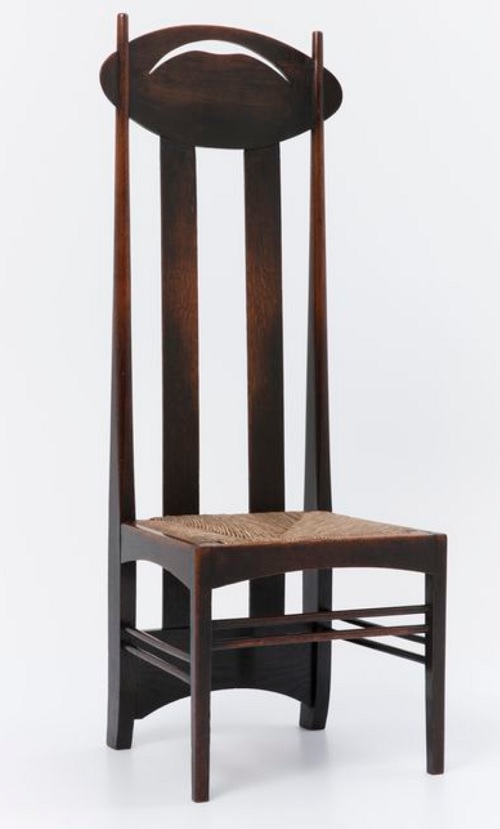
Other Mackintosh designs on film include his “Willow Chair” (c. 1902-1904), from the opening dining room scene of the Leonardo DiCaprio film “Inception,” and in the same film, a pair of his “Hill House” chandeliers (1903). Meanwhile, a single Mackintosh “Hill House Chair” (1903) features prominently in Patrick Bateman’s apartment in the film version of “American Psycho,” where it’s treated more like a work of sculpture than as a functional object.
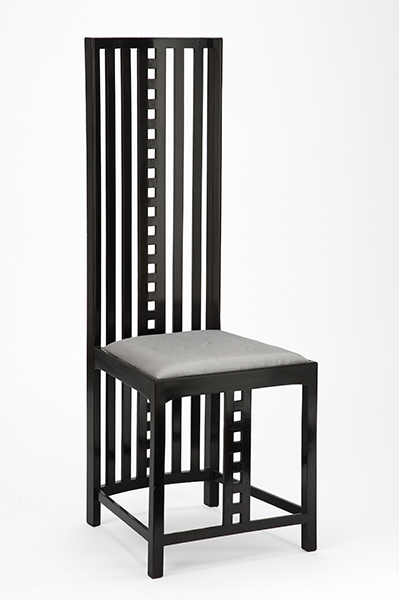
It’s curious to note that, in all of these examples, Mackintosh’s designs are associated with characters having some quality of detachment, coldness, or even ghoulishness, because in his own day, Mackintosh and his artistic circle were derided in some quarters for exhibiting just such qualities. As the Walters exhibition explains, while the working group of Mackintosh, his wife Margaret Macdonald, her sister Frances, and Frances’ husband Herbert MacNair called themselves “The Four,” many contemporary art critics referred to them pejoratively as the “Spook School.” It’s a moniker which has, to some extent, lingered over the group’s work down to the present day.
To be fair, Mackintosh’s art and designs are not as creepy as the erotic femmes fatales who populate the illustrations of his English contemporary Aubrey Beardsley (1872-1898), or the strung out prostitutes who fascinated the Austrian painter Egon Schiele (1890-1918). Before entering the exhibition, I wanted to dismiss the term “Spook School” as an old prejudice left over from a rather fussy, overly buttoned-up era. After seeing so many of Mackintosh’s drawings, paintings, and designs in this exhibition, however, I have to admit that there’s some truth to the characterization that this is somewhat spooky stuff, at least for the first part of his own career, as well as that of his closest collaborators in “The Four.”
Mackintosh Was Spiritual But not Religious
For one thing, there’s little joy in Mackintosh’s vision of what we more broadly refer to as “Art Nouveau,” and while there’s a great deal of sensuality to be found in his work, it’s not the sort of luxuriously pleasant stuff to be found in furniture by Louis Majorelle (1859-1926) or posters by Alphonse Mucha (1860-1939). There’s something rather terribly clinical about Mackintosh’s work during this period, almost as if he’s working from preserved specimen slides. They’re certainly interesting, intricate objects, and beautiful in their way, but I’m not sure that I’d want to live with them.
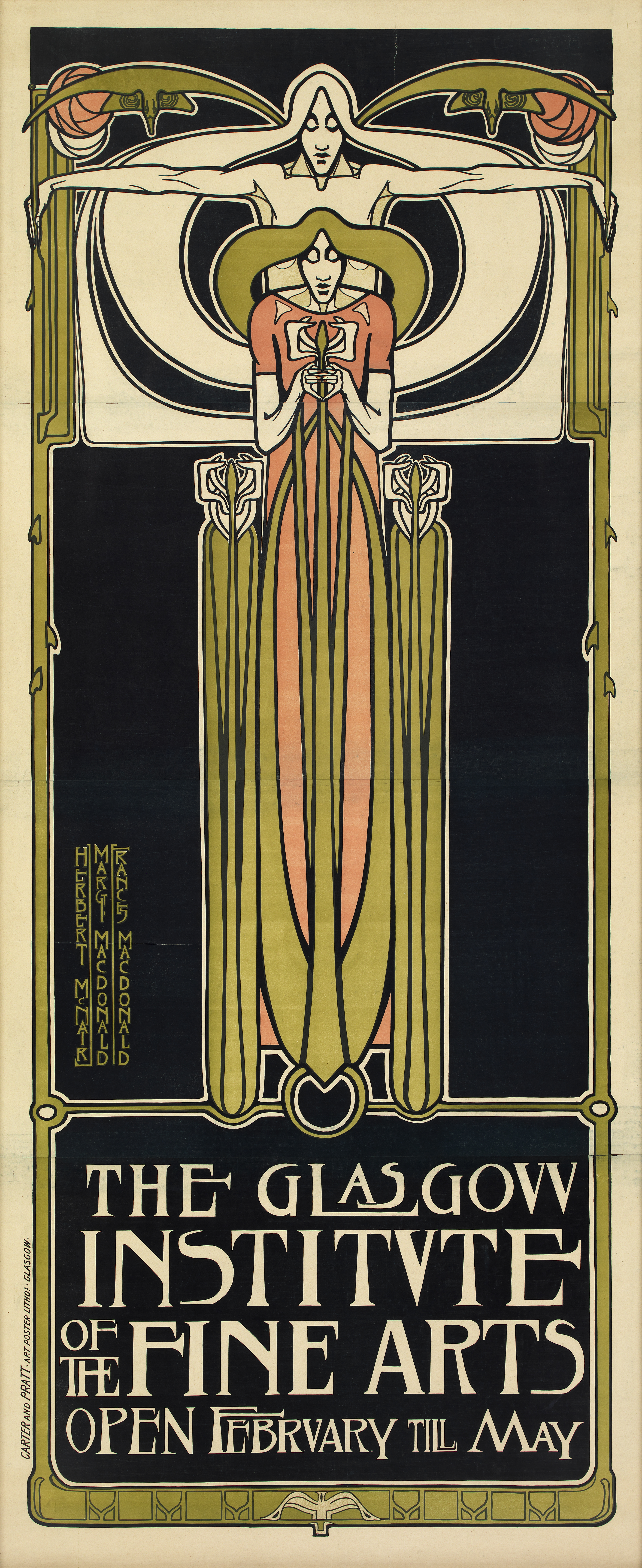
Then there’s the feeling that there’s something slightly “off” in Mackintosh’s Glasgow, without quite being able to put your finger on exactly what that is, a feeling my companions to the exhibition shared. There’s a whiff of the occult here and there, and although so far as we know the Mackintoshes never became theosophists, they certainly knew and associated with people who were deeply committed to that sort of pot-luck Gnosticism. A century before the cliché of, “I’m spiritual but not religious,” Mackintosh seems to be looking at everything spiritual except religion, in order to try to find meaning in his art. That was the case even when he received a commission for a religious building.
As shown in one of several short films on display in the exhibition, the only ecclesiastical building Mackintosh ever built was the former Queen’s Cross Church in Glasgow (1899). The exterior is somewhat foreboding, like a red sandstone reinterpretation of a limestone Norman fortress church. On the inside, the overturned ship’s hull of a roof, dark timbers, and heavy quoining don’t do much to lighten the mood, or indeed the spirit.
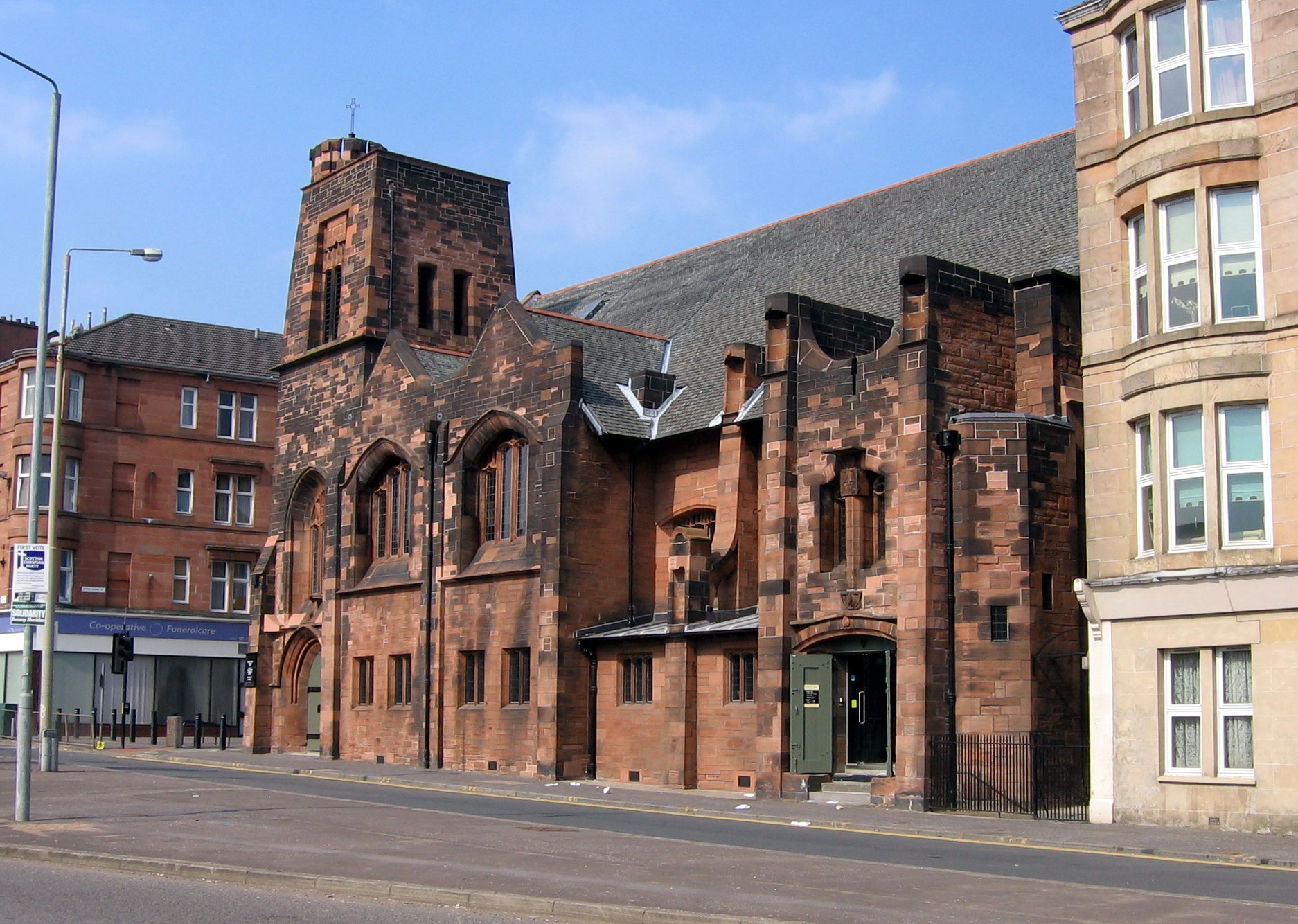
In fact, this now-deconsecrated church looks as though it was never consecrated in the first place, for there aren’t any crosses or other overtly Christian symbols on the inside, just a few Japanese-looking elements in the woodwork and stained glass. There’s what has to be considered a deliberate avoidance of Christianity in spots where one would expect to see it, such as in the rood beam separating the nave from the chancel. Normally, this architectural element would support either a cross or a depiction of Christ’s crucifixion, but in Mackintosh’s design, it serves merely as a place to put a lantern.
Mackintosh’s Transition from Architecture
For a while, Mackintosh was the “It” boy of the anti-establishment wing of the art and design world. He exhibited not only in his native Glasgow, but in London, Paris, and Vienna, where secessionists such as Gustav Klimt (1862-1918) and Josef Hoffmann (1870-1956) were so taken with him and his ideas that he and Margaret seriously considered moving there. Yet as inevitably happens, the Glasgow style eventually fell out of fashion, and Mackintosh entered a downward economic spiral.
He was asked to leave the architecture firm where he had worked since his teens and had risen to become a partner, because he was no longer bringing in enough business. When he and Margaret left for London to find work, that was effectively the end of the Glasgow style, since neither ever returned to Glasgow. Fortunately for exhibition visitors, however, the show doesn’t just stop there.
By the time of the First World War, the exhibition demonstrates how Mackintosh was designing interiors, fabrics, and book covers in a strikingly different, geometric style, a decade or more before what came to be called “Art Deco” became fashionable — and he had great difficulty attracting patrons as a result. The Walters show provides a number of examples of drawings, objects, and elements from this commercially unsuccessful period, and seeing Mackintosh’s stylistic evolution beyond the confines of the Glasgow style is really quite dramatic. By the 1920s, the Mackintoshes were living in Port-Vendres, a French fishing village on the Mediterranean close to the border with Spain, where the cost of living was far lower than that in London, and the weather, food, and drink were all infinitely better.
In this last stage of his artistic career, Mackintosh now turned his attention exclusively to painting, and four examples of his late, large watercolors conclude the Walters exhibition. They are absolutely glorious things: lush still lives with carefully observed profusions of flowers, and muscular landscapes depicting pastel buildings, shimmering blue water, and striped fields of rich golds and greens.
Gone are the spindly nymphs and stylized plants of the Glasgow style, and somehow, in the warmth of the Mediterranean sun, it seems as though Mackintosh found the joy that was so noticeably absent from his work up until that point. These final works hold a more substantial sort of beauty that might have marked the beginning of his comeback, but by this point it was just too late to start again.
What Ever Happened to ‘The Four’?
Bad health and bad finances brought on by a lifetime of heavy drinking and professional obstinance finally caught up with him, and in 1927, Mackintosh had to move back to London, where he died the following year. Margaret died there five years later, although she continued going back to visit Port-Vendres for as long as she could.
Of the remaining members of “The Four,” Herbert MacNair gave up art entirely once World War I started, frustrated that styles had changed and that the art world was no longer interested in what he had to say. He then worked a series of menial jobs to make ends meet for himself and Frances. When Frances died in 1921, Margaret gave up on art and never, so far as we know, painted again, while MacNair burned all of his and Frances’ remaining works of art, meaning the other two of “The Four” will always remain lesser-known figures to art historians and the public.
Although the Glasgow style only existed for a brief period of time, really only about a decade or so straddling the beginning of the 20th century, it produced some truly groundbreaking works of art, architecture, and design. These works paralleled those being created as a result of similar artistic developments taking place at the exact same time in other growing industrial cities around the world, from Chicago to Prague, Barcelona to Brussels.
Yet among these, the Glasgow style is perhaps the most tragic, for it ended so badly for many of its most prominent artists. You’ll come away from this exhibition impressed by the sheer scope and variety of what was achieved, but you’ll also wonder what might have been, had “The Four” been just a bit less spooky, and a bit more savvy.
“Designing the New: Charles Rennie Mackintosh and the Glasgow Style” is at the Walters Art Museum in Baltimore through Jan. 5, 2020.









